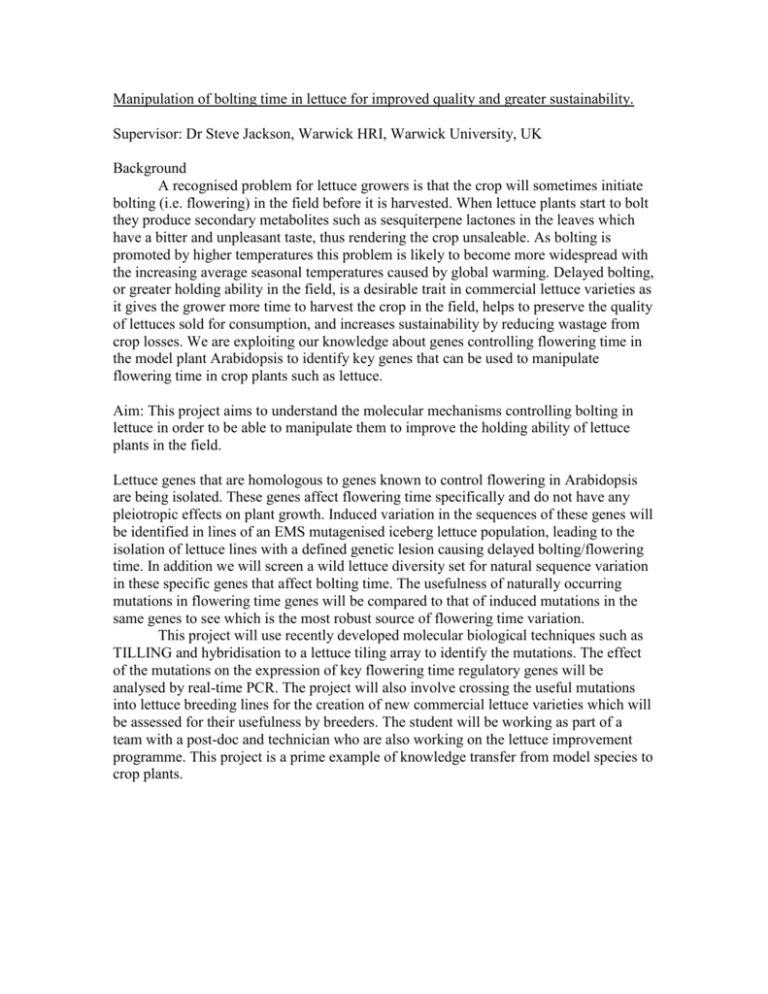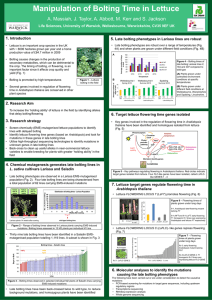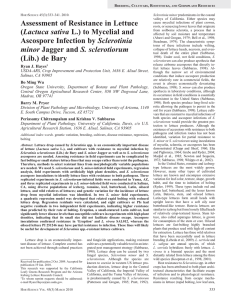Manipulation of bolting time in lettuce for improved quality and
advertisement

Manipulation of bolting time in lettuce for improved quality and greater sustainability. Supervisor: Dr Steve Jackson, Warwick HRI, Warwick University, UK Background A recognised problem for lettuce growers is that the crop will sometimes initiate bolting (i.e. flowering) in the field before it is harvested. When lettuce plants start to bolt they produce secondary metabolites such as sesquiterpene lactones in the leaves which have a bitter and unpleasant taste, thus rendering the crop unsaleable. As bolting is promoted by higher temperatures this problem is likely to become more widespread with the increasing average seasonal temperatures caused by global warming. Delayed bolting, or greater holding ability in the field, is a desirable trait in commercial lettuce varieties as it gives the grower more time to harvest the crop in the field, helps to preserve the quality of lettuces sold for consumption, and increases sustainability by reducing wastage from crop losses. We are exploiting our knowledge about genes controlling flowering time in the model plant Arabidopsis to identify key genes that can be used to manipulate flowering time in crop plants such as lettuce. Aim: This project aims to understand the molecular mechanisms controlling bolting in lettuce in order to be able to manipulate them to improve the holding ability of lettuce plants in the field. Lettuce genes that are homologous to genes known to control flowering in Arabidopsis are being isolated. These genes affect flowering time specifically and do not have any pleiotropic effects on plant growth. Induced variation in the sequences of these genes will be identified in lines of an EMS mutagenised iceberg lettuce population, leading to the isolation of lettuce lines with a defined genetic lesion causing delayed bolting/flowering time. In addition we will screen a wild lettuce diversity set for natural sequence variation in these specific genes that affect bolting time. The usefulness of naturally occurring mutations in flowering time genes will be compared to that of induced mutations in the same genes to see which is the most robust source of flowering time variation. This project will use recently developed molecular biological techniques such as TILLING and hybridisation to a lettuce tiling array to identify the mutations. The effect of the mutations on the expression of key flowering time regulatory genes will be analysed by real-time PCR. The project will also involve crossing the useful mutations into lettuce breeding lines for the creation of new commercial lettuce varieties which will be assessed for their usefulness by breeders. The student will be working as part of a team with a post-doc and technician who are also working on the lettuce improvement programme. This project is a prime example of knowledge transfer from model species to crop plants.






